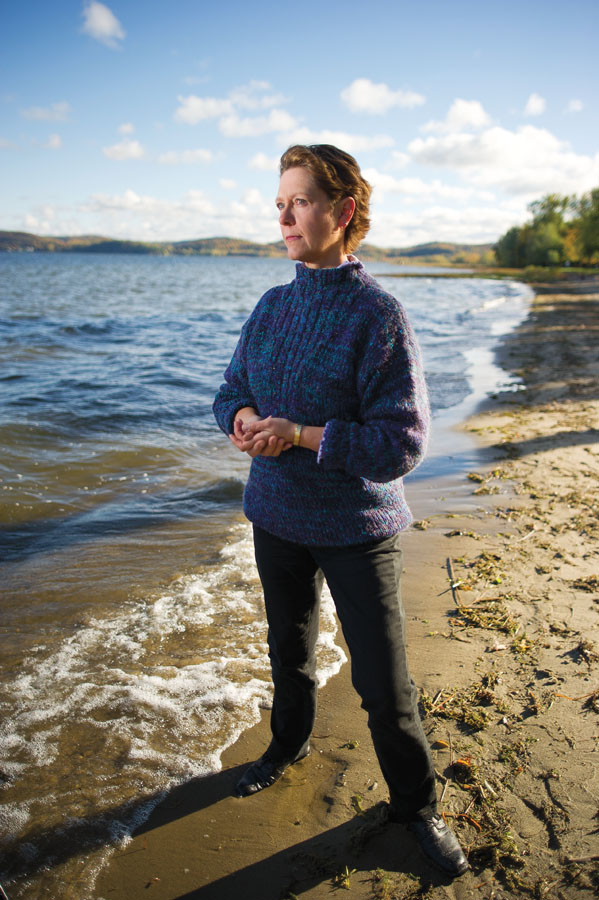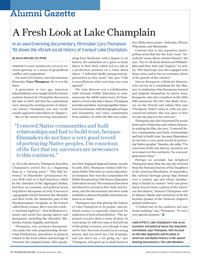Alumni Gazette
 LAKE EFFECT: Lake Champlain’s role as an economic and political nexus has long been overlooked, says Thompson, who focused on the lake (opposite) and its place in American and Native history in her award-winning documentary The Lake Between. (Photo: Andy Duback/AP Images for Rochester Review)
LAKE EFFECT: Lake Champlain’s role as an economic and political nexus has long been overlooked, says Thompson, who focused on the lake (opposite) and its place in American and Native history in her award-winning documentary The Lake Between. (Photo: Andy Duback/AP Images for Rochester Review)Vermont’s Lake Champlain: a placid vacation getaway or a nexus of geopolitical conflict and cooperation?
For most of its history, says documentary filmmaker Caro Thompson ’81, it was the latter.
A generation or two ago, American schoolchildren were taught that the French explorer Samuel de Champlain discovered the lake in 1609, and that his explorations were among the starting points of American history. Champlain, you may recall, usually appeared somewhere in Chapter 1.
But in her award-winning documentary, The Lake Between, Thompson describes Champlain’s arrival less as a beginning than as a “turning point.” “The lake between,” or Bitawbakw (pronounced bit-awe-BOK-wah) as it had long been called by the Abenakis of the Algonquin Nation, had been an economic and political nexus long before Europeans arrived. It served as a geographic barrier between the Abenakis and their rivals, the Mohawks, part of the Haudenosaunee (Iroquois, as the French called them) League. But it was also a link—a “maritime highway”—that facilitated economic and social ties among natives and Europeans, including the Abenakis, Mohawks, French, English, and Dutch.
Thompson, who produces documentaries under her sole proprietorship, Broadwing Productions, specializes in projects related to the local culture and heritage of Vermont, her adopted home. After graduating from Rochester with a degree in art history, she embarked on a quest to study dance in New York, which led to a job as a production assistant on a video about dance. “I followed totally unexpected opportunities as they arose,” she says. “Life is serendipitous when you keep your eyes opened.”
The Lake Between was a collaboration with Vermont Public Television to commemorate the 400th anniversary of Champlain’s arrival at the lake’s shores. Thompson provides narration, weaving together historical reenactments, still photographs of maps and documents, and video commentary from scholars. In 2009, the film won a Boston/New England Regional Emmy Award. In early 2010, Thompson worked with Vermont Public Television to create educational resources that won the Corporation for Public Broadcasting’s My Source Education Innovation Award. The resources have been distributed to schools in New York and Vermont, and the documentary has been made available to almost 100 public television stations in 43 states.
Thompson says that placing the history of Lake Champlain in its proper, international context is especially important for audiences of local schoolchildren. “The approach is to give them a sense of place. In rural areas, it’s still very easy to feel left out of the global economy, even though it may not be true. You look around you as a young person, and you don’t see a lot of people, and you don’t see a lot going on,” says Thompson, who grew up in small towns in four Midwestern states—Nebraska, Illinois, Wisconsin, and Minnesota.
Contrast that to the expansive metropolitan areas that line the East Coast. “Everybody learns about colonial history,” she says, “but it’s all about Boston and Philadelphia and New York and Virginia.” In reality, “this landscape was also engaged with those cities, and in fact an economic driver of the growth of the colonies.”
Darren Bonaparte, a Mohawk historian who served as a consultant for the film, says it emphasizes that Europeans learned and adapted themselves to native ways. Bonaparte, who also consulted on the 2006 PBS miniseries The War that Made America, on the French and Indian War, says Thompson “didn’t come in with any preconceived notions. She was open to how we saw our place in the universe.”
Thompson says she’s heartened by praise from native historians and culture bearers. In making the film, she says, “I entered Native communities and built relationships and had to build trust, because filmmakers do not have a very good record of portraying Native peoples.” Besides, she adds, “I’m conscious of the fact that my ancestors are newcomers to this continent. I’m a secondgeneration Dane.”
Perhaps no accolade has delighted Thompson more than the one she received from the National Society of the Daughters of the American Revolution. In September, the cultural heritage group that formed over a century ago and whose membership is limited to women “who can prove lineal descent from a patriot of the American Revolution,” honored Thompson with its History Medal and invited her to be the keynote speaker at the Vermont chapter’s annual conference.
“I looked out on the audience and saw heads nodding,” says Thompson. “It was a very special moment.”

